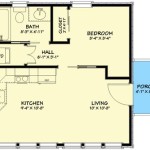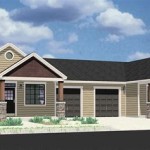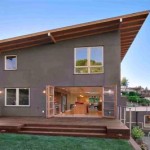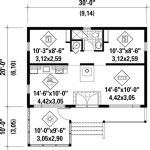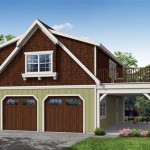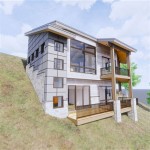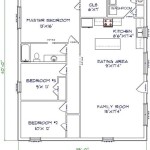Small House Plans With Elevators: Accessibility and Design Integration
The concept of small house living often evokes images of compact spaces, minimalist design, and efficient use of every square foot. Historically, the inclusion of an elevator in such designs was rare, primarily associated with larger, multi-story residences. However, evolving demographics, an increased focus on accessibility, and advancements in elevator technology have converged to make small house plans with elevators an increasingly viable and desirable option for a wider range of homeowners.
Traditionally, elevators were perceived as a luxury item, requiring significant space and substantial financial investment. Modern elevator technology has challenged these perceptions. Compact, residential elevators are now available, designed to integrate seamlessly into smaller homes without compromising valuable living space. These elevators often feature a smaller footprint, energy-efficient operation, and aesthetically pleasing designs, making them an attractive addition to small house plans.
The demand for small house plans with elevators is driven by a variety of factors. Aging in place is a significant consideration for many individuals. As people age, mobility can become increasingly challenging, making stairs a significant obstacle. An elevator provides a safe and convenient means of accessing all levels of the home, enabling individuals to remain in their own homes for longer, maintaining independence, and avoiding the need for relocation to assisted living facilities or other specialized accommodations. Furthermore, individuals with disabilities or mobility impairments, regardless of age, can benefit significantly from the inclusion of an elevator in a small house plan. Elevators provide accessibility and promote inclusivity, allowing all residents to fully enjoy and utilize every aspect of their home.
Beyond accessibility considerations, elevators can also enhance the overall functionality and convenience of a small house. Transporting groceries, luggage, or other heavy items between floors can be physically demanding. An elevator simplifies these tasks, making everyday life easier and more comfortable. Furthermore, an elevator can add a unique design element and increase the resale value of the home. Potential buyers often appreciate the added convenience and accessibility that an elevator provides, making the property more attractive in the real estate market.
Key Considerations When Planning a Small House With an Elevator
Integrating an elevator into a small house plan requires careful planning and consideration to ensure optimal functionality, safety, and compliance with building codes. Several key factors must be addressed during the design phase.
First, the size and location of the elevator shaft are paramount. The elevator shaft must be structurally sound and adequately sized to accommodate the elevator car and its operating mechanism. The location of the shaft should be strategically chosen to minimize disruption to the existing floor plan and maximize accessibility from all levels of the home. Careful consideration should be given to the headroom requirements for the elevator car, as well as the placement of the elevator machinery. Some elevators require a dedicated machine room, while others are machine-room-less (MRL), offering greater flexibility in terms of placement and space utilization. The choice between a traction elevator and a hydraulic elevator will also influence the space requirements and installation considerations.
Second, compliance with local building codes and accessibility standards is crucial. All elevator installations must adhere to specific codes and regulations regarding safety features, load capacity, emergency procedures, and accessibility requirements. These codes are designed to ensure the safety of the elevator occupants and prevent accidents. A qualified elevator contractor should be consulted to ensure that the installation meets all applicable regulations. Accessibility standards, such as those outlined in the Americans with Disabilities Act (ADA), may also apply, depending on the intended use of the elevator and the specific requirements of the jurisdiction.
Third, the integration of the elevator into the overall design aesthetic of the home is important. The elevator should not be viewed as a purely functional element but as an integral part of the home's architectural design. The elevator car's interior finishes, lighting, and door styles should complement the overall style of the house. Concealed elevator designs, where the elevator is hidden behind a panel or door when not in use, can be used to minimize the visual impact of the elevator on the interior space. Alternatively, glass-enclosed elevators can create a striking visual feature, adding a modern and sophisticated touch to the home. Careful attention to detail in the design and installation of the elevator can enhance the overall aesthetic appeal of the small house and create a seamless integration with the existing architecture.
Types of Elevators Suitable for Small Houses
Selecting the appropriate type of elevator for a small house is essential for ensuring optimal functionality, space efficiency, and cost-effectiveness. Several types of elevators are available, each with its own advantages and disadvantages.
Hydraulic elevators are a common choice for residential applications, particularly in low-rise buildings. They operate using a hydraulic piston that raises and lowers the elevator car. Hydraulic elevators are typically less expensive than traction elevators, but they may require a larger machine room and consume more energy. They also tend to have a slower travel speed compared to traction elevators. However, their relatively simple design and ease of maintenance make them a popular option for small houses with limited space and budget constraints.
Traction elevators, on the other hand, utilize ropes and a counterweight system to raise and lower the elevator car. Traction elevators are typically faster and more energy-efficient than hydraulic elevators. They also require a smaller machine room, or no machine room at all in the case of MRL elevators. MRL elevators are particularly well-suited for small houses where space is at a premium. However, traction elevators are generally more expensive to install and maintain than hydraulic elevators. The choice between a traction elevator and a hydraulic elevator will depend on factors such as budget, space availability, travel distance, and desired performance characteristics.
Pneumatic elevators, also known as vacuum elevators, are a relatively new type of elevator that operates using air pressure. These elevators consist of a cylindrical tube and a car that is lifted and lowered by creating a vacuum above the car. Pneumatic elevators are self-supporting and do not require a pit or machine room, making them relatively easy to install. They also have a small footprint and a modern, aesthetically pleasing design. However, pneumatic elevators typically have a lower load capacity and a slower travel speed compared to hydraulic and traction elevators. They are also generally more expensive than traditional elevators. Pneumatic elevators are best suited for small houses with limited space and a desire for a unique and visually appealing elevator solution.
Design and Construction Considerations for Elevator Integration
Integrating an elevator into a small house plan requires careful consideration of various design and construction factors to ensure a successful and seamless implementation. Careful planning and attention to detail are essential to avoid costly errors and ensure the long-term functionality and safety of the elevator.
Structural integrity is a paramount concern. The elevator shaft must be structurally sound and capable of supporting the weight of the elevator car and its occupants. A structural engineer should be consulted to assess the existing structure and determine the necessary modifications to accommodate the elevator shaft. Reinforcement may be required to ensure that the structure can adequately support the added weight and stresses. The elevator shaft should be constructed of fire-resistant materials to protect the occupants in the event of a fire. Proper insulation and soundproofing should also be incorporated to minimize noise transmission from the elevator to other parts of the house.
Accessibility and usability are also critical considerations. The elevator car should be designed to accommodate individuals with disabilities, including those who use wheelchairs or other mobility devices. The elevator car should be large enough to comfortably accommodate a wheelchair and at least one other person. The elevator controls should be easily accessible and operable from a seated position. The elevator doors should have a sufficient opening width to allow for easy passage of wheelchairs and other mobility devices. The elevator should also be equipped with safety features such as emergency lighting, an emergency stop button, and a telephone for contacting emergency services.
Finally, aesthetics and design integration play a significant role in the overall success of the elevator installation. The elevator should be integrated seamlessly into the overall design of the house, complementing the existing architectural style and interior decor. The elevator car's interior finishes, lighting, and door styles should be carefully selected to create a cohesive and visually appealing design. Concealed elevator designs can be used to minimize the visual impact of the elevator on the interior space, while glass-enclosed elevators can create a striking visual feature. Careful attention to detail in the design and installation of the elevator can enhance the overall aesthetic appeal of the small house and create a functional and beautiful living space.

House Plans With Residential Elevator Drummond

House Plans With Residential Elevator Drummond

House Plans With Residential Elevator Drummond

House Plans With Residential Elevator Drummond

House Plans With Residential Elevator Drummond

Contemporary House Plan With Elevator For The Narrow Lot 36546tx Architectural Designs Plans

House Plans With Residential Elevator Drummond

Two Story 4 Bedroom Southern Home With Elevator And Second Floor Balconies Plan Balcony House Plans Florida

2 Story 3 Bedroom Country Home With Elevator And Loft House Plan

Coastal Stilt House Plan With Elevator And Second Level Living Space 765044twn Architectural Designs Plans


